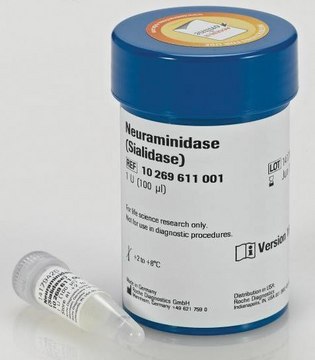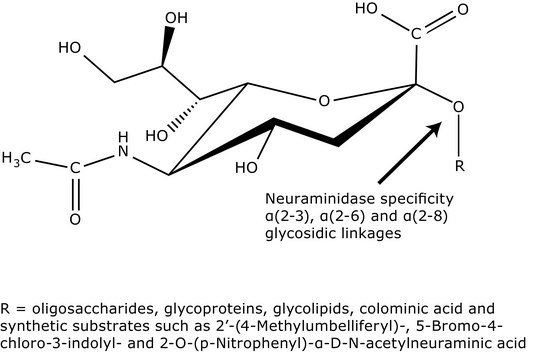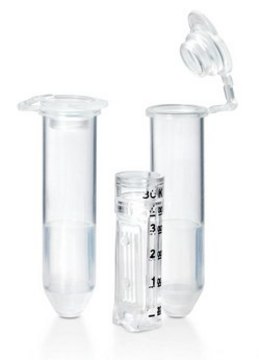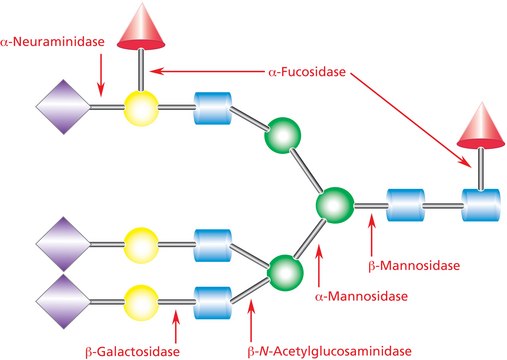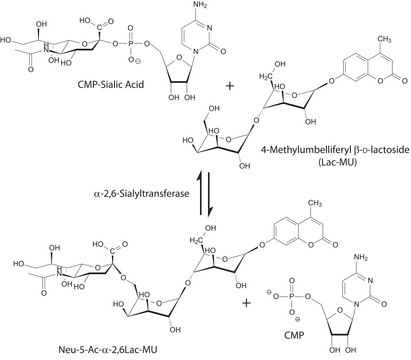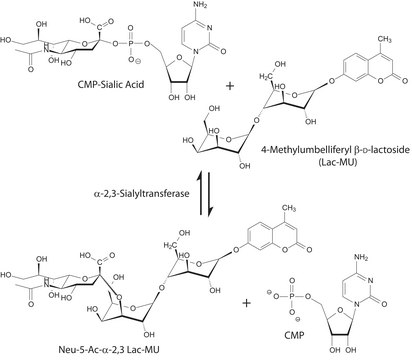推荐产品
生物来源
Vibrio cholerae
质量水平
表单
solution
分子量
~95 kDa
包装
pkg of 1 U
制造商/商品名称
Roche
最佳pH
5.5-6.2
适用性
suitable for ELISA applications
应用
life science and biopharma
sample preparation
运输
wet ice
储存温度
2-8°C
一般描述
神经氨酸酶是一种乙酰神经氨酸水解酶,可水解寡糖、多糖、粘多糖、糖蛋白和糖脂的α2,3-、α2,6-或α2,8-键连接的末端N-或O-乙酰神经氨酸(速率:α2,6 > α2,3 > α2,8)。值得注意的是,糖脂水解需要使用去污剂。该神经氨酸酶因其广泛的底物特异性而非常适用于从各种生物材料(例如,细胞学、细胞表面、病毒等)的糖复合物中完全去除唾液酸。
Approximately 40 U/mg enzyme protein at 37 °C and pH 5.5, with N-acetyl-neuraminosyl-D-lactose as the substrate.
特异性
水解半乳糖、Hex、NAc的α2,3-、α2,6-或α2,8键连接的末端N-或O-乙酰-神经氨酸,或者低聚糖/糖复合物或多聚唾液酸的N-或O-乙酰神经氨酰残基。水解的相对速率是α2,3 >α2,6 >α2,8,这是在三糖和四糖的键上测定得到的。
应用
神经氨酸酶已被用于:
- 去除CHO(中国仓鼠卵巢)细胞中的顺式作用唾液酸
- 以进行去糖基化研究
单位定义
一个单位是指在以下孵育条件下在+37°C环境中在1分钟内水解1 μmol N-乙酰-神经氨基-D-乳糖所需的酶活性:
10mM N-乙酰-神经氨基-D-乳糖,50mM乙酸钠,4mM氯化钙,牛血清白蛋白,100 μg/ml,pH 5.5。该活性是通过使用β-半乳糖苷酶/半乳糖脱氢酶方法测量释放的D-乳糖而确定的。在相同条件下,1 U神经氨酸酶每分钟可使1 μmol N-乙酰神经氨酸从人α1-酸性糖蛋白(10mg/ml孵育混合物)中分离出来。释放的N-乙酰-神经氨酸可以使用硫代巴比妥酸法等方法进行测定。
10mM N-乙酰-神经氨基-D-乳糖,50mM乙酸钠,4mM氯化钙,牛血清白蛋白,100 μg/ml,pH 5.5。该活性是通过使用β-半乳糖苷酶/半乳糖脱氢酶方法测量释放的D-乳糖而确定的。在相同条件下,1 U神经氨酸酶每分钟可使1 μmol N-乙酰神经氨酸从人α1-酸性糖蛋白(10mg/ml孵育混合物)中分离出来。释放的N-乙酰-神经氨酸可以使用硫代巴比妥酸法等方法进行测定。
外形
溶液含50 mM乙酸钠,154 mM氯化钠,9 mM氯化钙,0.1%Micr-O-Protect(w/v),人血清白蛋白,25mg/l,pH 5.5。该制剂含有10 mM EDTA。
注:根据目前的质量控制程序,用于该制剂的血清应检测HBs抗原以及是否存在HIV-1、HIV-2、HCV抗体,并且结果应为阴性。
注:根据目前的质量控制程序,用于该制剂的血清应检测HBs抗原以及是否存在HIV-1、HIV-2、HCV抗体,并且结果应为阴性。
其他说明
仅用于生命科学研究。不可用于诊断。
法律信息
本产品的销售不排除或授予第三方专利的任何权利,包括F.Hoffmann - La Roche AG集团所属公司的专利,特别是使用该产品获得的改造抗体的使用。
警示用语:
Warning
危险声明
危险分类
Skin Sens. 1
储存分类代码
12 - Non Combustible Liquids
WGK
WGK 1
闪点(°F)
does not flash
闪点(°C)
does not flash
法规信息
常规特殊物品
Direct Attachment with Erythrocytes Augments Extracellular Growth of Pathogenic Mycobacteria.
Nishiuchi, et al.
Microbiology spectrum, 10, e0245421-e0245421 (2022)
Angeles Canales et al.
JACS Au, 3(3), 868-878 (2023-04-04)
Influenza virus infection remains a threat to human health since viral hemagglutinins are constantly drifting, escaping infection and vaccine-induced antibody responses. Viral hemagglutinins from different viruses display variability in glycan recognition. In this context, recent H3N2 viruses have specificity for
Peter L Delputte et al.
Journal of virology, 81(17), 9546-9550 (2007-06-15)
The sialic acid-binding lectin sialoadhesin (Sn) is a macrophage-restricted receptor for porcine reproductive and respiratory syndrome virus (PRRSV). To investigate the importance of pSn sialic acid-binding activity for PRRSV infection, an R(116)-to-E mutation was introduced in the predicted sialic acid-binding
Misako Nakayama et al.
Methods in molecular biology (Clifton, N.J.), 2556, 37-43 (2022-09-30)
Hemagglutinin (HA) on the surface of influenza viruses binds to sialic acids, mainly N-acetylneuraminic acid (Neu5Ac) or N-glycolylneuraminic acid. Neu5Ac and N-glycolylneuraminic acid lie at the terminal end of sugar chains on the cell surface. Human influenza viruses preferentially bind
A previously uncharacterized O-glycopeptidase from Akkermansia muciniphila requires the Tn-antigen for cleavage of the peptide bond.
Medley, et al.
The Journal of biological chemistry, 298, 102439-102439 (2023)
实验方案
Neuraminidase can be used to cleave sialic acids from proteins. In this protocol, the enzyme from Vibrio cholerae is used on fixed cells.
我们的科学家团队拥有各种研究领域经验,包括生命科学、材料科学、化学合成、色谱、分析及许多其他领域.
联系技术服务部门